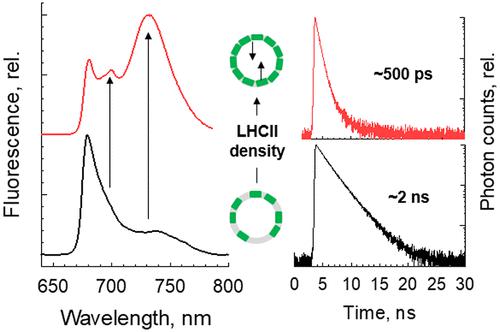当前位置:
X-MOL 学术
›
J. Phys. Chem. Lett.
›
论文详情
Our official English website, www.x-mol.net, welcomes your
feedback! (Note: you will need to create a separate account there.)
The Structural and Spectral Features of Light-Harvesting Complex II Proteoliposomes Mimic Those of Native Thylakoid Membranes
The Journal of Physical Chemistry Letters ( IF 4.8 ) Pub Date : 2022-06-16 , DOI: 10.1021/acs.jpclett.2c01019 Sam Wilson 1 , Dan-Hong Li 1 , Alexander V Ruban 1
The Journal of Physical Chemistry Letters ( IF 4.8 ) Pub Date : 2022-06-16 , DOI: 10.1021/acs.jpclett.2c01019 Sam Wilson 1 , Dan-Hong Li 1 , Alexander V Ruban 1
Affiliation

|
The major photosystem II light-harvesting antenna (LHCII) is the most abundant membrane protein in nature and plays an indispensable role in light harvesting and photoprotection in the plant thylakoid. Here, we show that “pseudothylakoid characteristics” can be observed in artificial LHCII membranes. In our proteoliposomal system, at high LHCII densities, the liposomes become stacked, mimicking the in vivo thylakoid grana membranes. Furthermore, an unexpected, unstructured emission peak at ∼730 nm appears, similar in appearance to photosystem I emission, but with a clear excimeric character that has never been previously reported. These states correlate with the increasing density of LHCII in the membrane and a decrease in its average fluorescence lifetime. The appearance of these low-energy states can also occur in natural plant membrane structures, which has unique consequences for the interpretation of the spectroscopic and physiological properties of the photosynthetic membrane.
中文翻译:

光捕获复合物 II 蛋白脂质体的结构和光谱特征模拟天然类囊体膜的结构和光谱特征
主要光系统II集光天线(LHCII)是自然界中最丰富的膜蛋白,在植物类囊体的光收集和光保护中起着不可或缺的作用。在这里,我们表明可以在人工 LHCII 膜中观察到“假类囊体特征”。在我们的蛋白脂质体系统中,在高 LHCII 密度下,脂质体堆积起来,模拟体内类囊体颗粒膜。此外,在约 730 nm 处出现了一个意想不到的非结构化发射峰,在外观上与光系统 I 发射相似,但具有以前从未报道过的清晰的准分子特征。这些状态与膜中 LHCII 密度的增加和其平均荧光寿命的减少有关。这些低能态的出现也可能出现在天然植物膜结构中,这对解释光合膜的光谱和生理特性具有独特的影响。
更新日期:2022-06-16
中文翻译:

光捕获复合物 II 蛋白脂质体的结构和光谱特征模拟天然类囊体膜的结构和光谱特征
主要光系统II集光天线(LHCII)是自然界中最丰富的膜蛋白,在植物类囊体的光收集和光保护中起着不可或缺的作用。在这里,我们表明可以在人工 LHCII 膜中观察到“假类囊体特征”。在我们的蛋白脂质体系统中,在高 LHCII 密度下,脂质体堆积起来,模拟体内类囊体颗粒膜。此外,在约 730 nm 处出现了一个意想不到的非结构化发射峰,在外观上与光系统 I 发射相似,但具有以前从未报道过的清晰的准分子特征。这些状态与膜中 LHCII 密度的增加和其平均荧光寿命的减少有关。这些低能态的出现也可能出现在天然植物膜结构中,这对解释光合膜的光谱和生理特性具有独特的影响。











































 京公网安备 11010802027423号
京公网安备 11010802027423号